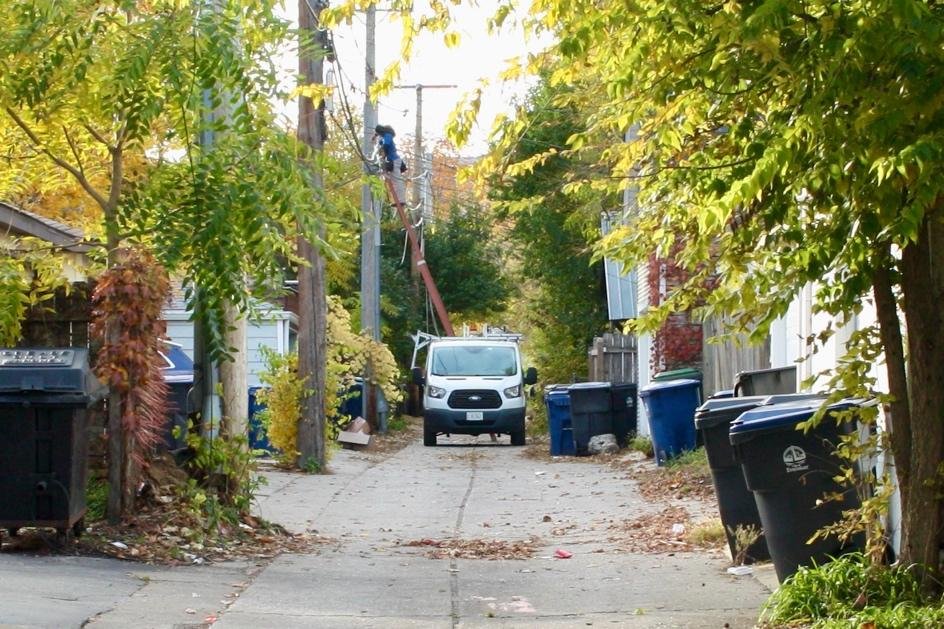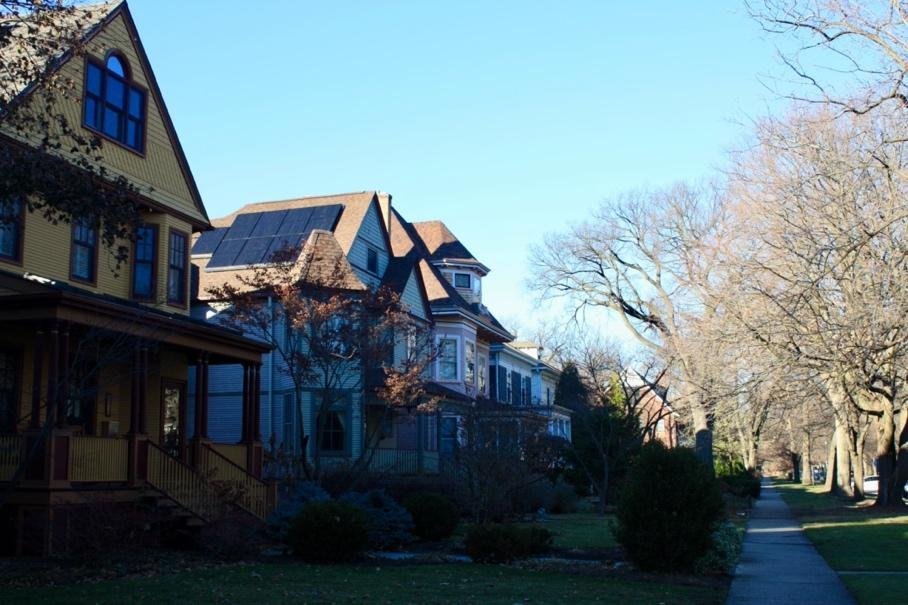Evanston Relies on Renewable Energy Credits to Meet Emission Reduction Targets
An electrician maintaining a power line. Photo by Jamie Dickman.
For Evanston, continuing to meet the city’s zero carbon targets by 2050 will require direct carbon reduction policies to move beyond buying renewable energy from the electric grid, the biggest contributor to the city’s emissions reductions.
By purchasing green energy from Chicago's electric grid, Evanston can assert sustainability without investing in local infrastructure changes.
“We're not going to get to our zero carbon by 2050 goal unless everybody in town is pulling in the same direction,” says 4th Ward Alderman and Environmental Board member Jonathan Nieuwsma.
Although the City of Evanston has been a sustainability leader with a progressive and successful track record, it has much more work to do.
When it comes to strategies to reduce local emissions, “a lot of the low-hanging fruit has already been picked,” he says. “It's going to get harder. It's going to require a higher investment of money, time, energy and manpower.”
Community Choice Aggregation was implemented in 2012, providing most residents with green energy services automatically, unless they chose to opt out. This method of meeting the electricity demand of Evanston with renewable energy allows the city to purchase Renewable Energy Certificates, or RECs, to fit demand. The program taps renewable energy from elsewhere that is available to the grid serving Evanston, giving city residents and the city itself emission reduction credits for tapping these reserves. The more RECs the city buys, the more emissions reductions it can claim.
Power lines outside an apartment building. Photo by Jamie Dickman
In October, Sustainability & Resilience Coordinator Cara Platt delivered a Climate Action and Resilience Plan Update to Evanston’s Environment Board. According to the progress report, Evanston is on track to complete its 2025, 2035, and 2050 emissions reduction goals. But as of now, meeting these goals depends on the city’s continued use of RECs.
“In the past and leading up until now, it was the right choice to rely on RECs to meet our goals,” Pratt says. “But moving forward we can't continue to do that, we need to start looking at local renewable energy resources and building electrification, because at some point there won't be RECs available to purchase.”
Increasing demand for clean energy means that RECs will become more scarce and expensive since electric grids produce a limited amount of renewable energy.
Currently, Northern Illinois’ energy supplier, ComEd, generates 6% of its electricity from renewable energy (wind and solar), 39% from natural gas, 21% from coal, and 33% from nuclear, according to ComEd’s June 2022 Environmental Disclosure.
The update communicates that the city’s dependence on RECs for emissions reductions presents a problem, “without renewable energy certificates (RECs), community-wide greenhouse gas emissions would have actually increased by 2% from 2020 to 2021.”
Evanston's Emissions by Category. Created by Jamie Dickman, Data courtesy of Cara Pratt.
Electricity is generated by burning fossil fuels such as coal, natural gas, and oil or by tapping renewable sources such as wind and solar. Nuclear is another large electric source, and while it doesn’t produce carbon emissions, it does create spent nuclear fuel wastes that remain radioactive for generations.
RECs are promises that each megawatt-hour of electricity generated comes from a renewable source. They are essentially credits that can be bought and sold until the energy is used. They track and assign a separate financial value to renewable energy and fund further project development, such as expanding wind and solar farms.
“[Buying RECs] is reducing emissions, but if you were just to look in Evanston without those RECs, what are we really doing?” says Kimberly Marion Suiseeya, a professor of political science at Northwestern University.
“There have been enough wind farms built in Illinois and neighboring states that there are extra renewable energy credits left over after the state buys the ones that they need to meet our state requirements,” Nieuwsma says. “Evanston has been capitalizing on these kinds of surplus renewable energy certificates to essentially claim dibs on the electrons coming from wind farms as they go on the grid.”
“It's really sort of a stop-gap measure until we can build up solar energy within Evanston or other alternative forms of energy,” Marion Suiseeya says. “It's better than nothing, but not the ideal.
“From the financial perspective, what we need to do is focus on the biggest emitting sources,” Pratt says. “For the city of Evanston, that's buildings.”
In addition to REC reliance, “one of our challenges moving forward is to develop a more direct relationship with the actual production,” Nieuwsma says. “Wind energy is not an option in Evanston at the moment. Whatever we can do to facilitate rooftop solar is important.”
For example, Citizens Greener Evanston Board member Joel Freeman has taken advantage of the incentives offered by solar programs, such as tax credits and rebates, and installed solar on the roof of his home.
Solar panels on an Evanston home. Photo by Jamie Dickman.
He says, “my electric bill for the last five months has been zero because of the excess that I produce. If I make more in the daytime than I'm using in my home now, then that extra goes into the grid, and I get paid for it.”
Freeman points out that not all roofs are good candidates for solar panels, whether they’re too small, lack structural integrity, or are blocked by shade. Optimal panel output comes from south-facing roofs, which catch the most direct sunlight. Still, there are plenty of underutilized spaces in Evanston to generate energy via solar besides homes.
One example he identifies is schools, which usually have large, flat roofs–perfect for installing solar panels.
Besides houses and schools, the roofs of large apartment complexes, manufacturing or warehouse facilities, and many of Northwestern University’s facilities are great candidates.
Installing solar in municipal facilities is a current project for the city: Robert Crown Community Center, Evanston Animal Shelter and the Evanston Water Treatment Plant are all short-term targets, Pratt says. “We would benefit from directly getting the electricity instead of buying the RECs. I'm hoping by April of 2024 we can pull that off.”
There are multiple reasons why these opportunities haven’t already been taken. In addition to cost, generating green energy isn’t high enough on the to-do list for residents and institutions.
Marion Suiseeya explains that choosing strategic policies and streamlining climate action goals into the city-wide budget would be huge progress. “It takes away the need for people to always think in terms of environment versus other needs, that automatic trade off that comes into people's minds: should we be spending money on solar power, or should we be spending it on addressing income inequality in Evanston?” she says.
“If you invested in solar power in certain parts of Evanston, you could also simultaneously be addressing income inequality by providing a low-cost source of energy,” says Marion Suiseeya.
Strategically using existing resources is a priority, Nieuwsma says. “The 2023 budget is the greenest budget we've ever had, with an increasing commitment to hiring more people in the sustainability department, but also taking a really close look at sustainability in every other area.”
Pratt points to an affordable housing retrofit program as a potential solution, allowing low-income households to acquire home improvements that reduce carbon emissions, such as improving insulation, replacing gas-powered appliances with electric models, and installing solar. These changes would allow many low-income homes to become net zero.
Nieuwsma, Pratt, Marion Suiseeya, and Freeman all highlight community engagement as essential in tackling environmental issues like climate change and emission reduction.
Getting involved with local sustainability organizations, such as Citizens’ Greener Evanston, going to ward meetings, contacting your local alderman, even researching sustainable opportunities are all great ways to engage.
“Part of what’s getting more effective and a little bit easier to do is the advocacy. When there's choices to be made, the city doesn't have an infinite amount of money. So, each year when they create the budget, they gotta make choices,” Freeman says.
He adds that the city council members want to be responsive to their constituency. “If their citizens and their membership say we want more trees where there aren't any trees, then they'll fund the forestry folks a little bit more. And if enough people are clamoring for it, then they'll make sure that stuff is in [the budget] for that,” Freeman says.
Despite all the work to be done, between balancing budgets, reforming policy and building sustainable infrastructure, it's important not to lose sight of the big picture.
Freeman says, “Impacts from the effects of the resulting climate change have to be taken into account and prepared for so that people don't suffer as much as if you did nothing, you know?”
“I think one thing to keep in mind is that not fully meeting the targets is not what defines failure,” he says. “Failure is doing nothing.”




